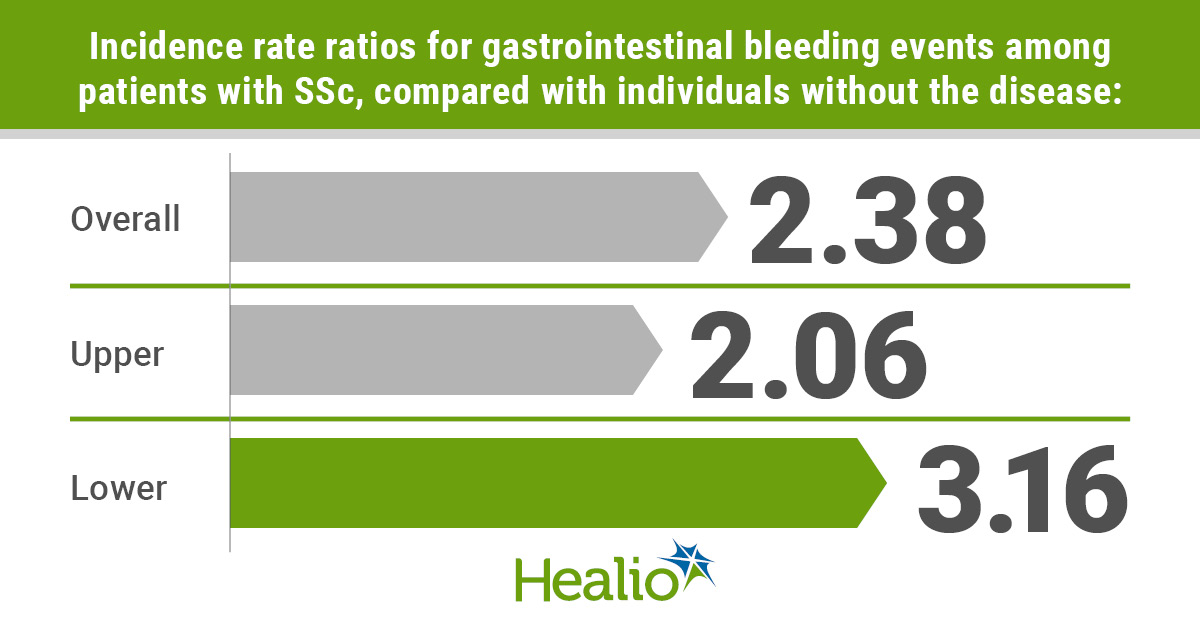Systemic sclerosis linked to higher risk for gastrointestinal bleeding
Patients with systemic sclerosis are at a significantly higher risk for gastrointestinal bleeding compared with those without the disease, according to data published in Arthritis Research & Therapy.
“GI involvement is one of the most common disease manifestations in SSc,” Yi-Ting Lin, MD, of the Kaohsiung Medical University Hospital in Taiwan, and colleagues wrote. “According to EULAR Scleroderma Trial and Research (EUSTAR) cohort, 3% SSc patients died related to gastrointestinal causes as the primary cause of death. Videocapsule endoscopy in patients with SSc demonstrated a high frequency of GI mucosal abnormalities, with a marked predominance of vascular mucosal damage. The involvement of the GI tract may lead to profuse hemorrhage.”
“A hospital-based study demonstrated higher risks of severe GI hemorrhage in patients with SSc,” they added. “However, small sample size, cross-sectional study design without longitudinal follow-up, and lack of comparison groups limit the result interpretation.”
To examine how SSc impacts the risk for gastrointestinal bleeding — both in the upper and lower tracts — Lin and colleagues analyzed information from a pair of Taiwan-based national databases. Focusing on data from 1998 to 2007, the researchers identified and included a total of 3,665 adults with SSc from the Catastrophic Illness Patient Database. These patients were then matched 1:5 to 18,324 control individuals without SSc — based on age, sex and index date — from the National Health Insurance Research Database.

All patients and control individuals were followed until either the occurrence of gastrointestinal bleeding, death or the end of 2008. The researchers used a subdistribution hazards model to determine the risk for gastrointestinal bleeding, adjusting for age, sex, comorbidity, medications and time-dependent covariates.
According to the researchers, the risk for overall gastrointestinal bleeding was significantly increased for patients with SSc (incidence rate ratio [IRR] = 2.38; 95% CI, 2.02-2.79), compared with control individuals without the disease. Patients also had an increased risk for upper (IRR = 2.06; 95% CI, 1.68-2.53) and lower (IRR = 3.16; 95% CI, 2.53-3.96) gastrointestinal bleeding, compared with controls.
In the competing death risk, based on the subdistribution hazards model with time-covariate adjustment, SSc was an independent risk factor for over-all gastrointestinal bleeding (sHR = 2.98; 95% CI, 2.21-4.02), upper gastrointestinal bleeding (sHR = 2.8; 95% CI, 1.92-4.08) and lower gastrointestinal bleeding (sHR = 3.93; 95% CI, 2.52-6.13).
“SSc patients independently exhibit increased GI bleeding risk, including that of the upper (peptic and non-peptic ulcer) and lower GI bleeding, particularly in men and those with diabetes mellitus, hypertension and adverse drug exposure (NSAIDs, antiplatelets, steroids),” Lin and colleagues wrote. “Gastroenterologists, rheumatologists, and primary health care providers should be aware of GI bleeding risk in SSc patients, and esophagogastroduodenoscopy and monitoring for GI complications should be considered.” – by Jason Laday
Disclosure: The researchers report no relevant financial disclosures.
